Response of Nutritional Status and Tea Quality to the Rate and Substitution of Chemical Fertilizers with Organic Manure
Abstract
1. Introduction
2. Materials and Methods
2.1. Field Experiment
2.2. Samples and Measurements
2.3. Calculation of Agronomic Use Efficiency and Profit
2.4. Estimation of Greenhouse Gas Emissions Derived from Fertilization
2.5. Statistical Analysis
3. Results
3.1. Yield, Nutrient Absorption, and Nutrient Use Efficiency
3.2. Tea Quality
3.3. Soil Properties
3.4. Estimation of Greenhouse Gas Emissions
4. Discussion
4.1. Response of Tea Yield, Quality Parameters, and Soil Property to Nutrient Application Rates
4.2. The Efficacy of Full and Partial Organic Substitution
5. Conclusions
Supplementary Materials
Author Contributions
Funding
Data Availability Statement
Conflicts of Interest
References
- Zhou, B.; Chen, Y.; Zeng, L.; Cui, Y.; Li, J.; Tang, H.; Liu, J.; Tang, J. Soil nutrient deficiency decreases the postharvest quality-related metabolite contents of tea (Camellia sinensis (L.) Kuntze) leaves. Food Chem. 2022, 377, 132003. [Google Scholar] [CrossRef] [PubMed]
- Venkatesan, S.; Ganapathy, M.N.K. Impact of nitrogen and potassium fertiliser application on quality of CTC teas. Food Chem. 2004, 84, 325–328. [Google Scholar] [CrossRef]
- Lin, Z.-H.; Qi, Y.-P.; Chen, R.-B.; Zhang, F.-Z.; Chen, L.-S. Effects of phosphorus supply on the quality of green tea. Food Chem. 2012, 130, 908–914. [Google Scholar] [CrossRef]
- Ruan, J.Y.; Ma, L.F.; Shi, Y.Z. Potassium management in tea plantations: Its uptake by field plants, status in soils, and efficacy on yields and quality of teas in China. J. Plant Nutr. Soil Sci. 2013, 176, 450–459. [Google Scholar] [CrossRef]
- Tang, S.; Zheng, N.; Ma, Q.; Zhou, J.; Sun, T.; Zhang, X.; Wu, L. Applying Nutrient Expert system for rational fertilisation to tea (Camellia sinensis) reduces environmental risks and increases economic benefits. J. Clean. Prod. 2021, 305, 127197. [Google Scholar] [CrossRef]
- Ni, K.; Liao, W.Y.; Yi, X.Y.; Niu, S.Y.; Ma, L.F.; Shi, Y.Z.; Zhang, Q.F.; Liu, M.Y.; Ruan, J.Y. Fertilization status and reduction potential in tea gardens of China. J. Plant Nutr. Fert. 2019, 25, 421–432. [Google Scholar]
- Mishima, S.; Endo, A.; Kohyama, K. Nitrogen and phosphate balance on crop production in Japan on national and prefectural scales. Nutr. Cycl. Agroecosyst. 2010, 87, 159–173. [Google Scholar] [CrossRef]
- Ruan, J.Y.; Haerdter, R.; Gerendas, J. Impact of nitrogen supply on carbon/nitrogen allocation: A case study on amino acids and catechins in green tea [Camellia sinensis (L.) O. Kuntze] plants. Plant Biol. 2010, 12, 724–734. [Google Scholar] [CrossRef]
- Ding, Z.; Jia, S.; Wang, Y.; Xiao, J.; Zhang, Y. Phosphate stresses affect ionome and metabolome in tea plants. Plant Physiol. Biochem. 2017, 120, 30–39. [Google Scholar] [CrossRef]
- Liu, M.-Y.; Burgos, A.; Ma, L.; Zhang, Q.; Tang, D.; Ruan, J. Lipidomics analysis unravels the effect of nitrogen fertilization on lipid metabolism in tea plant (Camellia sinensis L.). BMC Plant Biol. 2017, 17, 165. [Google Scholar] [CrossRef]
- Chen, Y.; Wang, F.; Wu, Z.; Jiang, F.; Yu, W.; Yang, J.; Chen, J.; Jian, G.; You, Z.; Zeng, L. Effects of long-term nitrogen fertilization on the formation of metabolites related to tea quality in subtropical China. Metabolites 2021, 11, 146. [Google Scholar] [CrossRef]
- Yang, X.; Ni, K.; Shi, Y.Z.; Yi, X.Y.; Zhang, Q.F.; Fang, L.; Ma, L.F.; Ruan, J.Y. Effects of long-term nitrogen application on soil acidification and solution chemistry of a tea plantation in China. Agric. Ecosyst. Environ. 2018, 252, 74–82. [Google Scholar] [CrossRef]
- Hirono, Y.; Watanabe, I.; Nonaka, K. Trends in water quality around an intensive tea-growing area in Shizuoka, Japan. Soil Sci. Plant Nutr. 2009, 55, 783–792. [Google Scholar] [CrossRef]
- Yan, P.; Shen, C.; Fan, L.; Li, X.; Zhang, L.; Zhang, L.; Han, W. Tea planting affects soil acidification and nitrogen and phosphorus distribution in soil. Agric. Ecosyst. Environ. 2018, 254, 20–25. [Google Scholar] [CrossRef]
- Wang, Y.; Yao, Z.; Pan, Z.; Wang, R.; Yan, G.; Liu, C.; Su, Y.; Zheng, X.; Butterbach-Bahl, K. Tea-planted soils as global hotspots for N2O emissions from croplands. Environ. Res. Lett. 2020, 15, 104018. [Google Scholar] [CrossRef]
- Xie, S.; Feng, H.; Yang, F.; Zhao, Z.; Hu, X.; Wei, C.; Liang, T.; Li, H.; Geng, Y. Does dual reduction in chemical fertilizer and pesticides improve nutrient loss and tea yield and quality? A pilot study in a green tea garden in Shaoxing, Zhejiang Province, China. Environ. Sci. Pollut. Res. 2019, 26, 2464–2476. [Google Scholar] [CrossRef] [PubMed]
- Ji, L.; Wu, Z.; You, Z.; Yi, X.; Ni, K.; Guo, S.; Ruan, J. Effects of organic substitution for synthetic N fertilizer on soil bacterial diversity and community composition: A 10-year field trial in a tea plantation. Agric. Ecosyst. Environ. 2018, 268, 124–132. [Google Scholar] [CrossRef]
- Ji, L.; Ni, K.; Wu, Z.; Zhang, J.; Yi, X.; Yang, X.; Ling, N.; You, Z.; Guo, S.; Ruan, J. Effect of organic substitution rates on soil quality and fungal community composition in a tea plantation with long-term fertilization. Biol. Fertil. Soils 2020, 56, 633–646. [Google Scholar] [CrossRef]
- Gu, S.; Hu, Q.; Cheng, Y.; Bai, L.; Liu, Z.; Xiao, W.; Gong, Z.; Wu, Y.; Feng, K.; Deng, Y.; et al. Application of organic fertilizer improves microbial community diversity and alters microbial network structure in tea (Camellia sinensis) plantation soils. Soil Tillage Res. 2019, 195, 104356. [Google Scholar] [CrossRef]
- Wei, Z.; Ying, H.; Guo, X.; Zhuang, M.; Cui, Z.; Zhang, F. Substitution of mineral fertilizer with organic fertilizer in maize systems: A meta-analysis of reduced nitrogen and carbon emissions. Agronomy 2020, 10, 1149. [Google Scholar] [CrossRef]
- Wei, Z.; Hoffland, E.; Zhuang, M.; Hellegers, P.; Cui, Z. Organic inputs to reduce nitrogen export via leaching and runoff: A global meta-analysis. Environ. Pollut. 2021, 291, 118176. [Google Scholar] [CrossRef] [PubMed]
- Qiu, S.L.; Wang, L.M.; Huang, D.F.; Lin, X.J. Effects of fertilization regimes on tea yields, soil fertility, and soil microbial diversity. Chilean J. Agric. Res. 2014, 74, 333–339. [Google Scholar] [CrossRef]
- Das, S.; Borua, P.K.; Bhagat, R.M. Soil nitrogen and tea leaf properties in organic and conventional farming systems under humid sub-tropical conditions. Org. Agric. 2016, 6, 119–132. [Google Scholar] [CrossRef]
- Liu, J.W.; Zhang, Q.F.; Liu, M.Y.; Ma, L.F.; Shi, Y.Z.; Ruan, J.Y. Metabolomic analyses reveal distinct change of metabolites and quality of green tea during the short duration of a single spring season. J. Agric. Food Chem. 2016, 64, 3302–3309. [Google Scholar] [CrossRef]
- Ma, L.F.; Shi, Y.Z.; Ruan, J.Y. Nitrogen absorption by field-grown tea plants (Camellia sinensis) in winter dormancy and utilization in spring shoots. Plant Soil 2019, 442, 127–140. [Google Scholar] [CrossRef]
- Han, W.Y.; Wang, D.H.; Fu, S.W.; Ahmed, S. Tea from organic production has higher functional quality characteristics compared with tea from conventional management systems in China. Biol. Agric. Hortic. 2018, 34, 120–131. [Google Scholar] [CrossRef]
- Wang, L.; Yue, C.; Cao, H.L.; Zhou, Y.H.; Zeng, J.M.; Yang, Y.J.; Wang, X.C. Biochemical and transcriptome analyses of a novel chlorophyll-deficient chlorina tea plant cultivar. BMC Plant Biol. 2014, 14, 352. [Google Scholar] [CrossRef] [PubMed]
- Zhang, Q.F.; Liu, M.Y.; Ruan, J.Y. Integrated transcriptome and metabolic analyses reveals novel insights into free amino acid metabolism in Huangjinya tea cultivar. Front. Plant Sci. 2017, 8, 291. [Google Scholar] [CrossRef]
- Yamashita, H.; Kambe, Y.; Ohshio, M.; Kunihiro, A.; Tanaka, Y.; Suzuki, T.; Nakamura, Y.; Morita, A.; Ikka, T. Integrated metabolome and transcriptome analyses reveal etiolation-induced metabolic changes leading to high amino acid contents in a light-sensitive Japanese albino tea cultivar. Front. Plant Sci. 2021, 11, 611140. [Google Scholar] [CrossRef]
- Ruan, J.Y.; Ma, L.; Yi, X.; Shi, Y.; Ni, K.; Liu, M.; Zhang, Q. Integrated nutrient management in tea plantation to reduce chemical fertilizer and increase nutrient use efficiency. J. Tea Sci. 2020, 40, 85–95, (Chinese with English abstract). [Google Scholar]
- Ziadi, Z.; Sen Tran, T. Mehlich 3-Extractable Elements. In Soil Sampling and Methods of Analysis, 2nd ed.; Carter, M.R., Gregorich, E.G., Eds.; CRC Press: Boca Raton, FL, USA, 2007; pp. 117–124. [Google Scholar] [CrossRef]
- Tong, B.X.; Hou, Y.; Wang, S.Q.; Ma, W.Q. Partial substitution of urea fertilizers by manure increases crop yield and nitrogen use efficiency of a wheat-maize double cropping system. Nutr. Cycl. Agroecosyst. 2022. [Google Scholar] [CrossRef]
- Hergoualc’h, K.; Akiyama, H.; Bernoux, M.; Chirinda, N.; del Prado, A.; Kasimir, Å.; MacDonald, J.D.; Ogle, S.M.; Regina, K.; van der Weerden, T.J. N2O emissions from managed soils, and CO2 emissions from lime and urea application. In 2019 Refinement to the 2006 IPCC Guidelines for National Greenhouse Gas Inventories Volume 4 Agriculture, Forestry and Other Land Use; Calvo Buendia, E., Tanabe, K., Kranjc, A., Baasansuren, J., Fukuda, M., Ngarize, S., Osako, A., Pyrozhenko, Y., Shermanau, P., Federici, S., Eds.; The Intergovernmental Panel on Climate Change: Geneva, Switzerland, 2019; Volume 4. [Google Scholar]
- Forster, P.; Ramaswamy, V.; Artaxo, P.; Berntsen, T.; Betts, R.; Fahey, D.W.; Haywood, J.; Lean, J.; Lowe, D.C.; Myhre, G.; et al. Changes in Atmospheric Constituents and in Radiative Forcing. In Climate Change 2007: The Physical Science Basis. Contribution of Working Group I to the Fourth Assessment Report of the Intergovernmental Panel on Climate Change; Solomon, S., Qin, D., Manning, M., Chen, Z., Marquis, M., Averyt, K.B., Tignor, M., Miller, H.L., Eds.; Cambridge University Press: Cambridge, UK, 2007; pp. 129–234. [Google Scholar]
- Zhang, W.F.; Dou, Z.X.; He, P.; Ju, X.-T.; David, P. New technologies reduce greenhouse gas emissions from nitrogenous fertilizer in China. Proc. Natl. Acad. Sci. 2013, 110, 8375–8380. [Google Scholar] [CrossRef] [PubMed]
- Zheng, S. Study on the Monitoring Methods of Nitrate Leaching and Features of Nitrogen Leaching in Tea Plantation; Chinese Academy of Agricultural Sciences: Beijing, China, 2022. [Google Scholar]
- Liu, J.; Liu, M.; Fang, H.; Zhang, Q.; Ruan, J. Accumulation of amino acids and flavonoids in young tea shoots is highly correlated with carbon and nitrogen metabolism in roots and mature leaves. Front. Plant Sci. 2021, 12, 756433. [Google Scholar] [CrossRef]
- Cui, Z.; Wang, G.; Yue, S.; Wu, L.; Zhang, W.; Zhang, F.; Chen, X. Closing the N-use efficiency gap to achieve food and environmental security. Environ. Sci. Technol. 2014, 48, 5780–5787. [Google Scholar] [CrossRef] [PubMed]
- Yao, Z.; Zhang, D.; Yao, P.; Zhao, N.; Li, Y.; Zhang, S.; Zhai, B.; Huang, D.; Ma, A.; Zuo, Y.; et al. Optimizing the synthetic nitrogen rate to balance residual nitrate and crop yield in a leguminous green-manured wheat cropping system. Sci. Total Environ. 2018, 631–632, 1234–1242. [Google Scholar] [CrossRef]
- Heckrath, G.; Brookes, P.C.; Poulton, P.R.; Goulding, K.W.T. Phosphorus leaching from soils containing different phosphorus concentrations in the broadbalk experiment. J. Environ. Qual. 1995, 24, 904–910. [Google Scholar] [CrossRef]
- Li, H.; Huang, G.; Meng, Q.; Ma, L.; Yuan, L.; Wang, F.; Zhang, W.; Cui, Z.; Shen, J.; Chen, X.; et al. Integrated soil and plant phosphorus management for crop and environment in China. A review. Plant Soil 2011, 349, 157–167. [Google Scholar] [CrossRef]
- Ma, L.; Yang, Y.; Shi, Y.; Ruan, J.; Han, W. Application of an universal soil extractant of Mehlich-3 to nutrient analysis of tea garden soil. Chin. J. Soil Sci. 2007, 38, 745–748. [Google Scholar] [CrossRef]
- Lester, G.E.; Saftner, R.A. Organically versus conventionally grown produce: Common production inputs, nutritional quality, and nitrogen delivery between the two systems. J. Agric. Food Chem. 2011, 59, 10401–10406. [Google Scholar] [CrossRef]
- Long, L.; Shi, Y.; Ma, L.; Ruan, J. Characterization of young shoot population, yield, and nitrogen demands of tea (Camellia sinensis L.) harvested under different standards. Horticulturae 2022, 8, 275. [Google Scholar] [CrossRef]
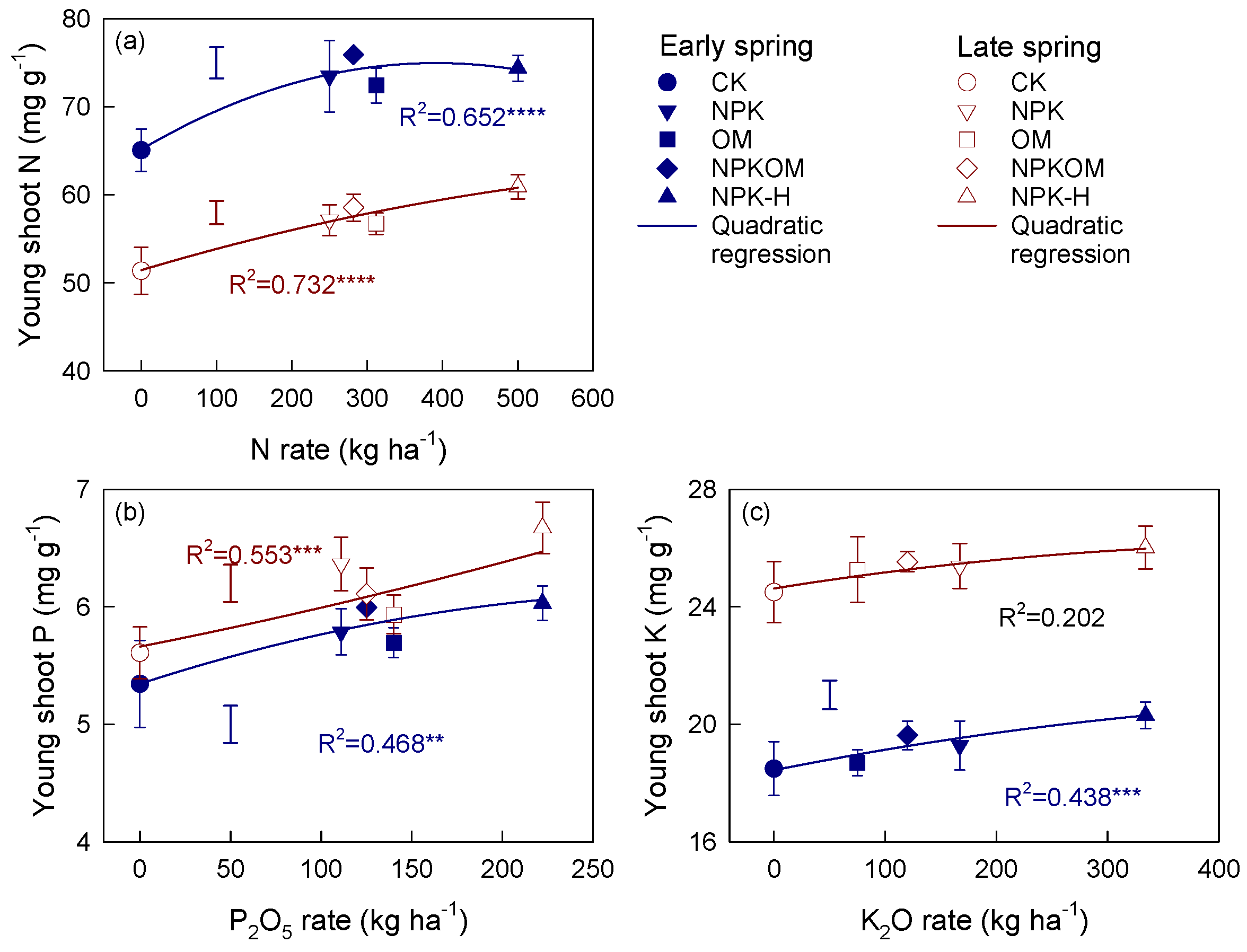
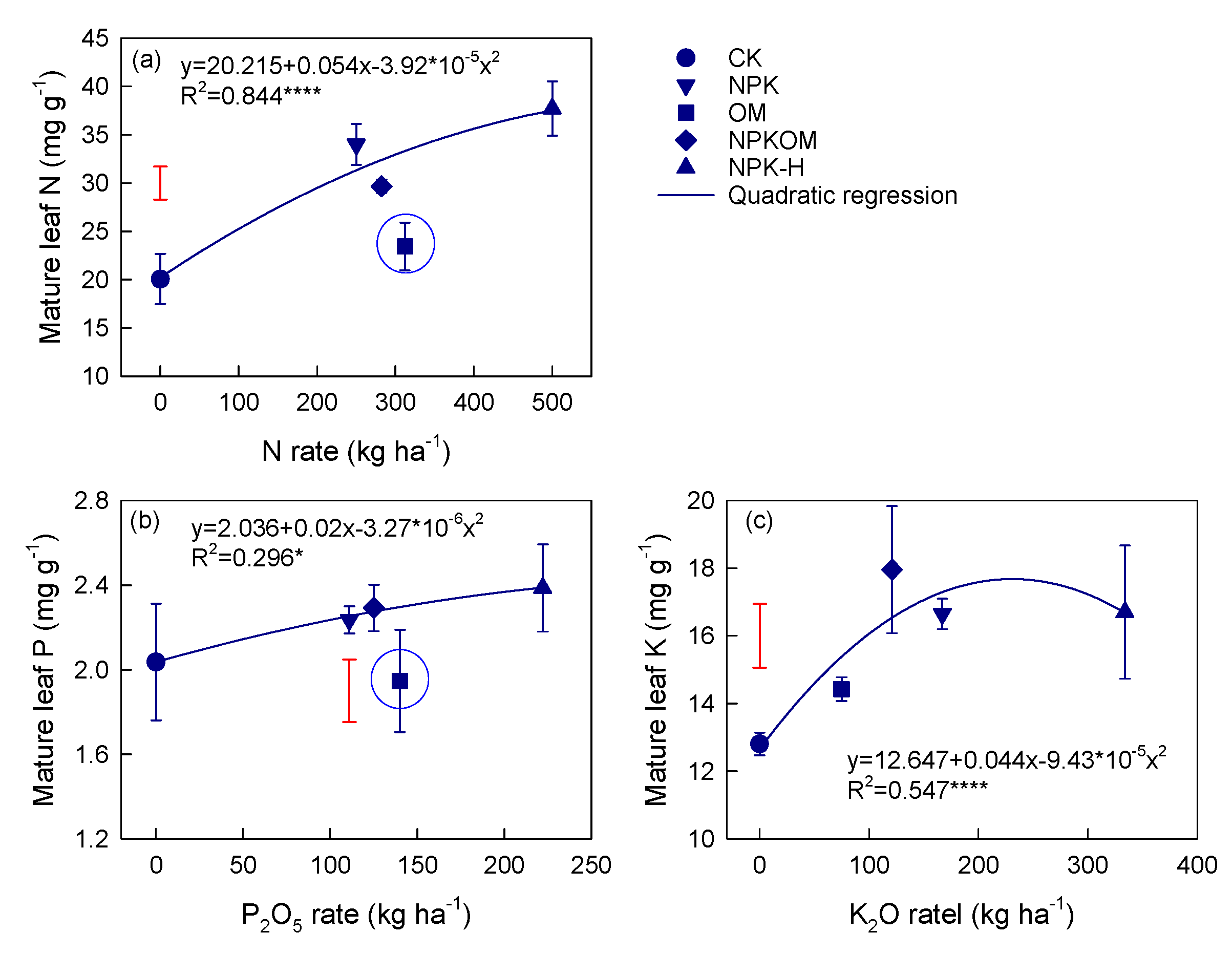
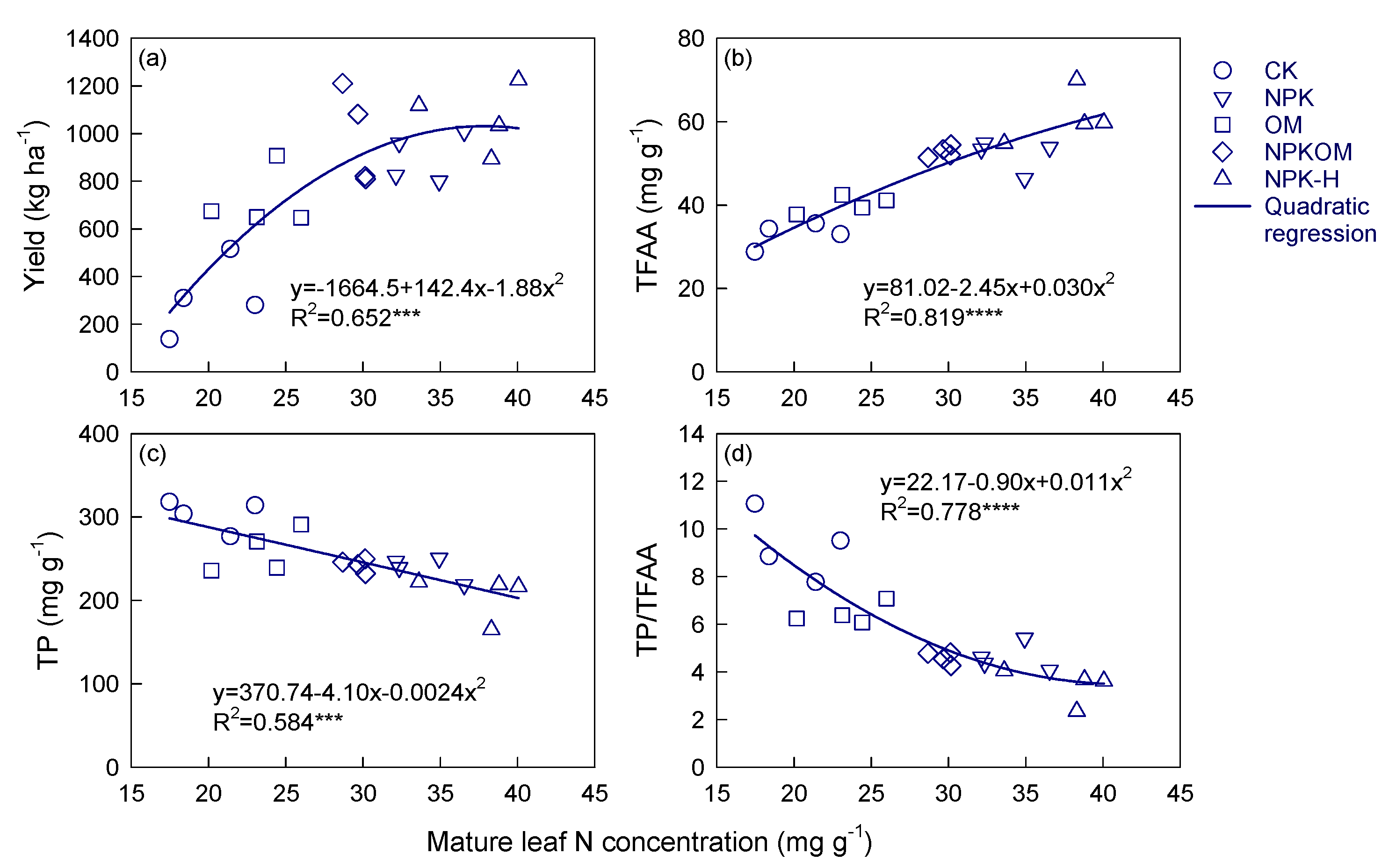
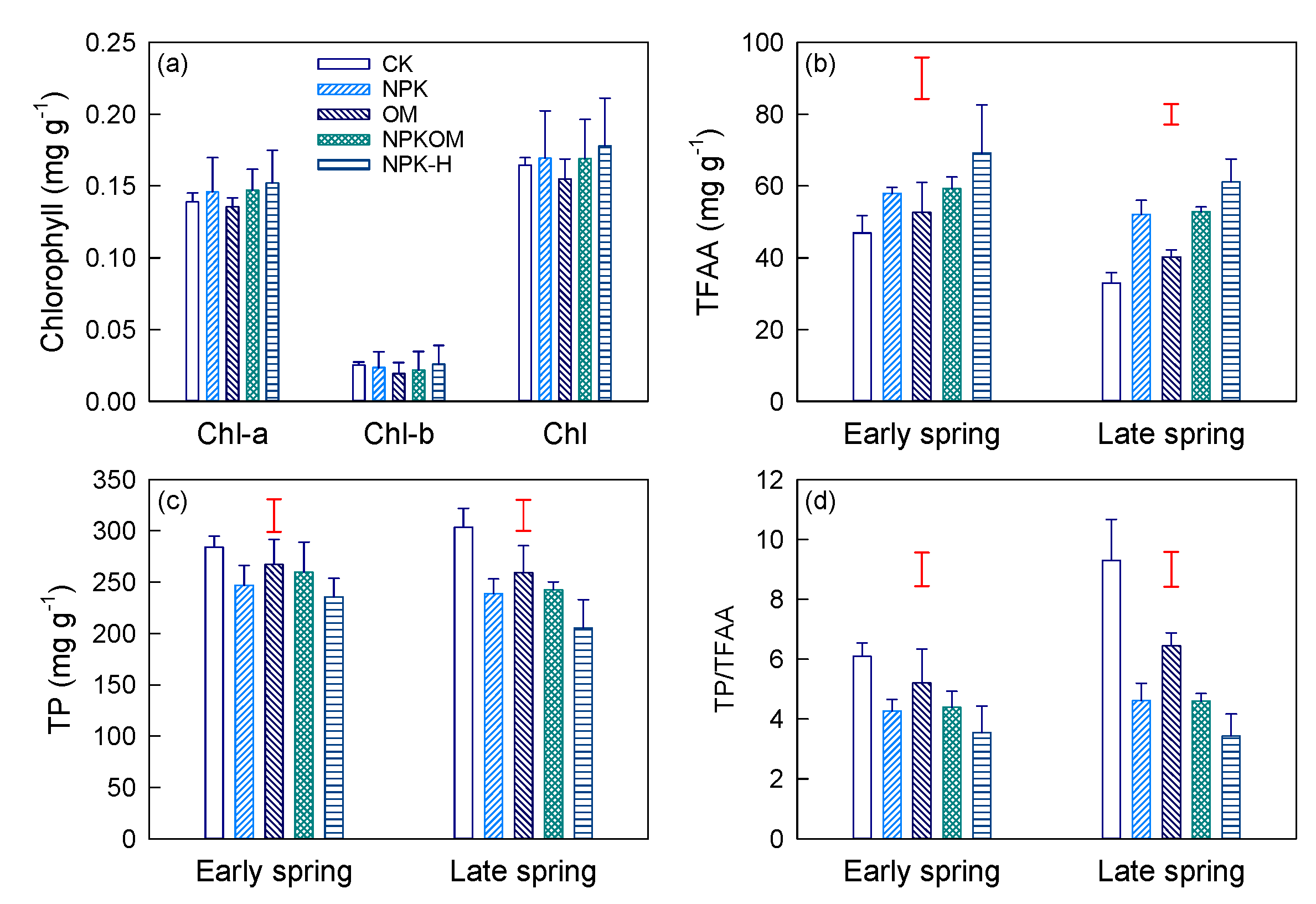
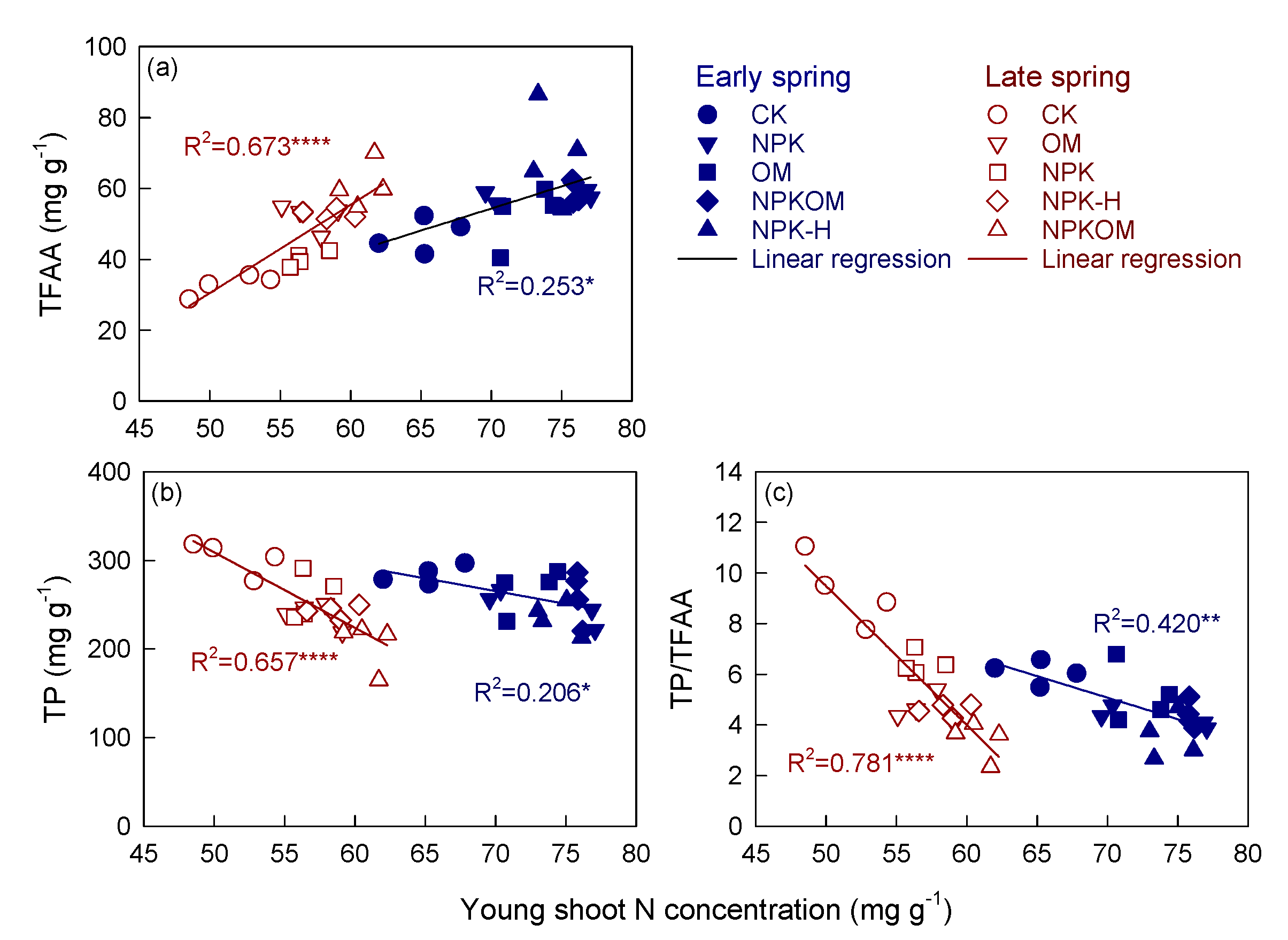
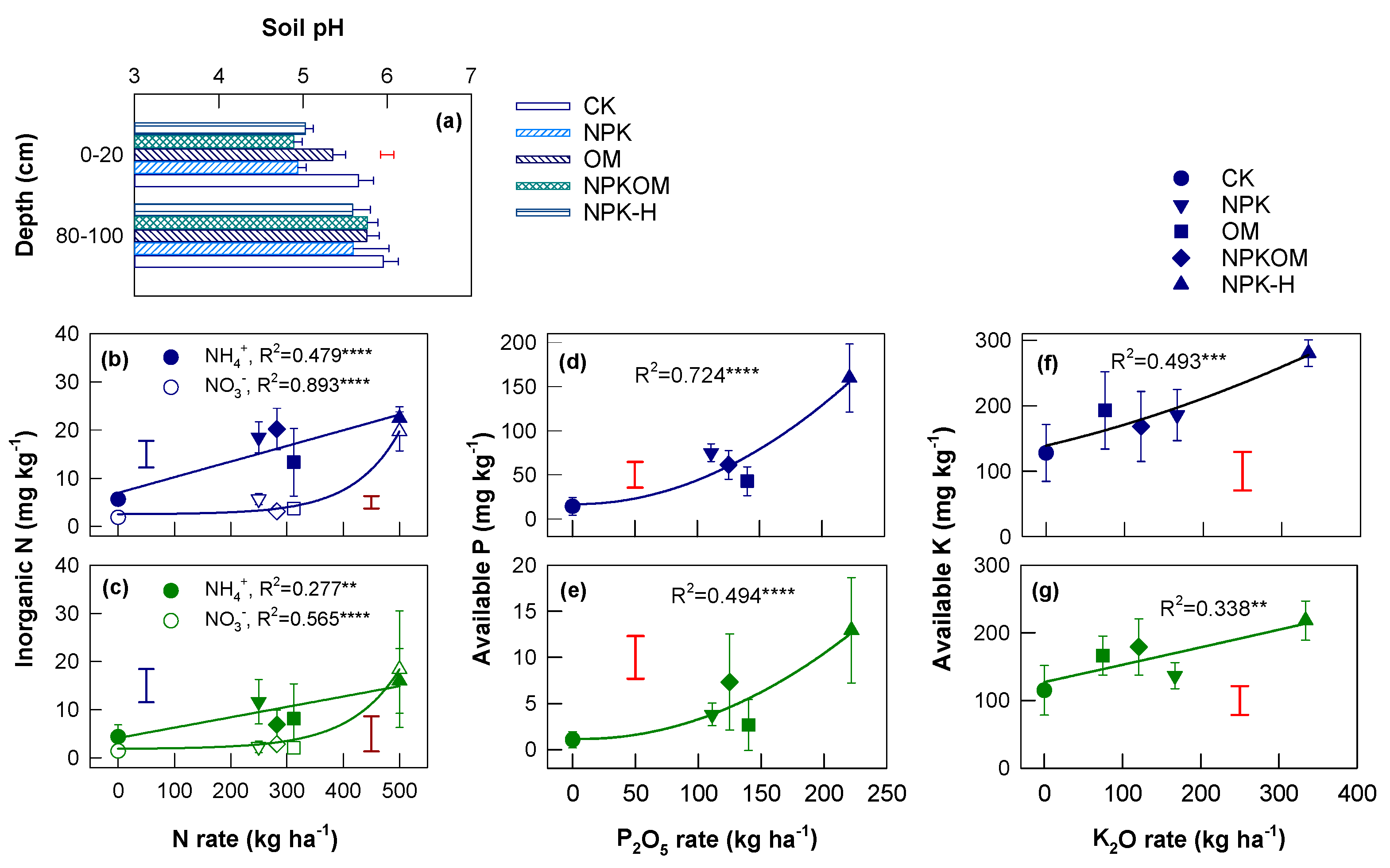
| Nutrient | Treatment | |||||
|---|---|---|---|---|---|---|
| CK | NPK | OM | NPKOM | NPK-H | ||
| Total (kg ha−1) | N | 0 | 250 | 312 | 282 | 500 |
| P2O5 | 0 | 110 | 140 | 125 | 220 | |
| K2O | 0 | 167 | 75 | 120 | 334 | |
| Sum | 0 | 527 | 527 | 527 | 1054 | |
| Organic (kg ha−1) | N | 0 | 0 | 312 | 158 | 0 |
| P2O5 | 0 | 0 | 140 | 70 | 0 | |
| K2O | 0 | 0 | 75 | 37 | 0 | |
| Sum | 0 | 0 | 527 | 264 | 0 | |
| Cost (CNY ha−1) | 0 | 7200 | 20,250 | 12,600 | 11,370 | |
| Treatment | Yield (kg ha−1) | Profit | Profit/Cost | ||
|---|---|---|---|---|---|
| 2019 | 2020 | Mean | (CNY ha−1) | Ratio | |
| CK | 569a | 312a | 440a | 0 | / |
| NPK | 812b | 898bc | 855b | 64,957 | 9.0 |
| OM | 824b | 720b | 772b | 43,235 | 2.1 |
| NPKOM | 836b | 981bc | 908b | 67,603 | 5.4 |
| NPK-H | 791b | 1068c | 929b | 70,261 | 6.2 |
| Treatment | Amount (kg ha−1) | AE (kg kg−1) | GHGA | GHGY | GHGP | |||||
|---|---|---|---|---|---|---|---|---|---|---|
| N | P | K | N | P2O5 | K2O | Sum # | (kg ha−1) | (kg kg−1) | (kg Yuan−1) | |
| CK | 6.0a | 0.58a | 2.34a | / | / | / | / | 0 | 0 | 0 |
| NPK | 12.8bcd | 1.18bc | 4.33b | 1.66b | 3.74b | 2.48a | 0.79b | 4596 | 5.38 | 0.071 |
| OM | 11.9bc | 1.07b | 4.04b | 1.06a | 2.37a | 4.42b | 0.63ab | 4179 | 5.41 | 0.097 |
| NPKOM | 13.4cd | 1.22bc | 4.54b | 1.66b | 3.74b | 3.87b | 0.89b | 4401 | 4.85 | 0.065 |
| NPK-H | 14.0d | 1.27c | 4.62b | 0.98a | 2.20a | 1.46a | 0.46a | 9192 | 9.89 | 0.131 |
Publisher’s Note: MDPI stays neutral with regard to jurisdictional claims in published maps and institutional affiliations. |
© 2022 by the authors. Licensee MDPI, Basel, Switzerland. This article is an open access article distributed under the terms and conditions of the Creative Commons Attribution (CC BY) license (https://creativecommons.org/licenses/by/4.0/).
Share and Cite
Ma, L.; Zhu, Y.; Geng, S.; Ruan, J. Response of Nutritional Status and Tea Quality to the Rate and Substitution of Chemical Fertilizers with Organic Manure. Horticulturae 2022, 8, 1198. https://doi.org/10.3390/horticulturae8121198
Ma L, Zhu Y, Geng S, Ruan J. Response of Nutritional Status and Tea Quality to the Rate and Substitution of Chemical Fertilizers with Organic Manure. Horticulturae. 2022; 8(12):1198. https://doi.org/10.3390/horticulturae8121198
Chicago/Turabian StyleMa, Lifeng, Yun Zhu, Saipan Geng, and Jianyun Ruan. 2022. "Response of Nutritional Status and Tea Quality to the Rate and Substitution of Chemical Fertilizers with Organic Manure" Horticulturae 8, no. 12: 1198. https://doi.org/10.3390/horticulturae8121198
APA StyleMa, L., Zhu, Y., Geng, S., & Ruan, J. (2022). Response of Nutritional Status and Tea Quality to the Rate and Substitution of Chemical Fertilizers with Organic Manure. Horticulturae, 8(12), 1198. https://doi.org/10.3390/horticulturae8121198







